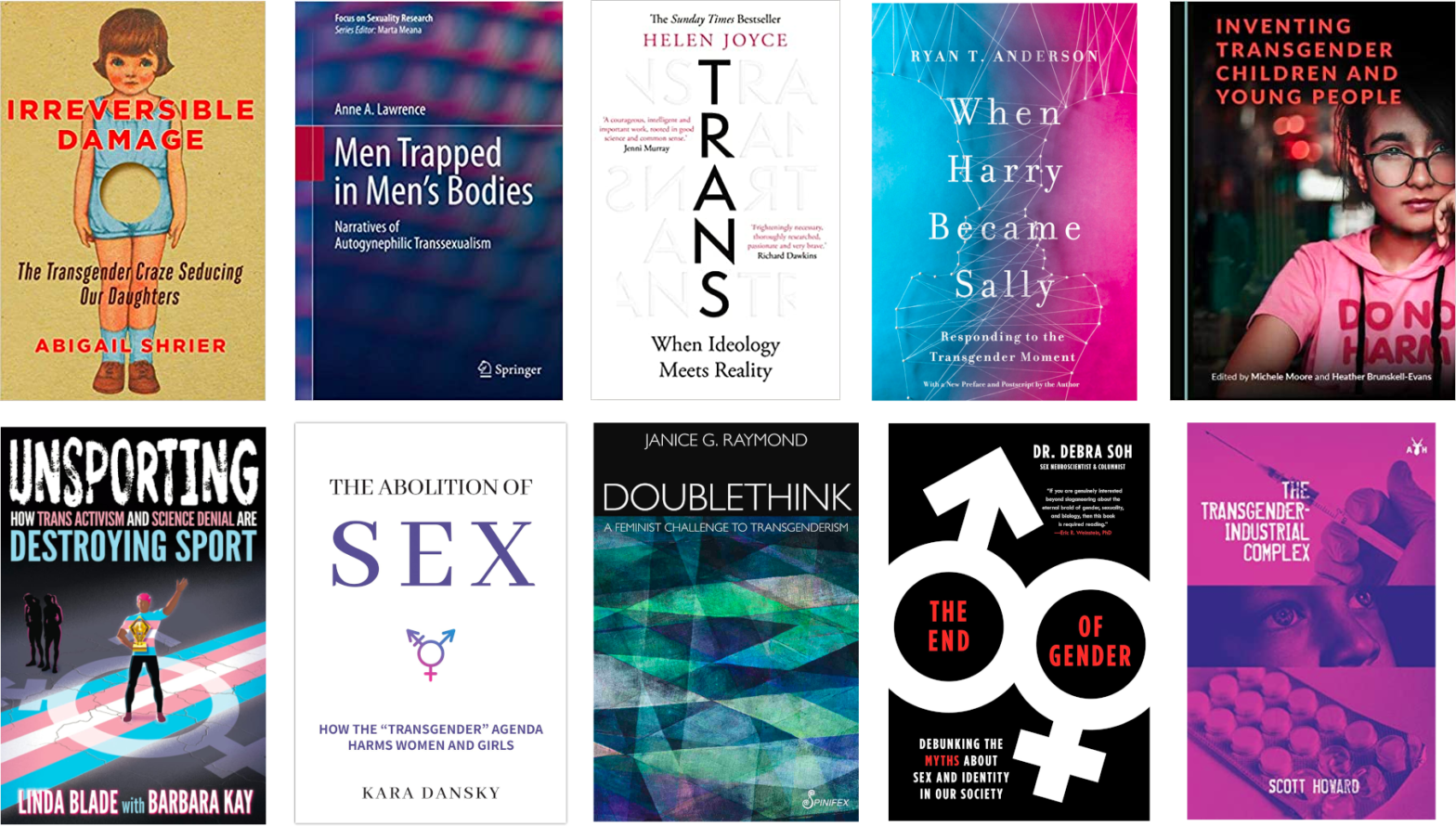Some history
Up until very recently, gender diverse people were shut out of the publishing world.
If they wanted to exchange ideas in print, they had to do it in their own newsletters and zines such as in Friedrich Radszuweit’s Das 3. Geschlecht – Die Transvestiten (translation: “The 3rd sex – the transvestites”, 1930-1932) or Rupert Raj’s Gender Review (1978-1986).
Not that there weren’t books on trans people, but they were either medical texts written by cisgender people such as Magnus Hirschfeld/Max Tilke’s Die Transvestiten (1910), Harry Benjamin’s The Transsexual Phenomenon (1966) and Richard Green/John Money’s Transsexualism and Sex Reassignment (1969), or they were autobiographies of trans anti-celebrities such as Lili Elbe’s Fra mand til kvinde (translation: “From man to woman”, 1931), Christine Jorgensen’s A Personal Autobiography (1967), Dianna Boileau’s Behold, I am a woman (1972) and April Ashley’s Odyssey (1982). Publishers weren’t interested in trans voices otherwise; this was a society that regarded queer people as dangerously unfit and outlawed trans women wearing dresses.
It wasn’t until the 1990s when small feminist and academic presses began to publish trans authors like Lou Sullivan, Kate Bornstein, Leslie Feinberg and Vivian Namaste. It would take until the 2000s/early 2010s to have a steady trickle of English-language titles, with most substantive works being published either by Vancouver-based Arsenal Pulp Press or the since-defunct trans-run Topside Press. Zines were still thriving in the vacuum, and Tumblr was taking off as a new way for particularly young gender diverse folk to connect with ideas, displacing forums such as Susan’s Place.
Despite societal inroads, established publishers had barely progressed. Interest increased after the “trans tipping point” of 2013-ish that upgraded trans people to the still reductive status of tragic figures, but it was more of the same: ghost written trans celebrity biographies they could market to cis audiences from the likes of Chaz Bono, Caitlyn Jenner, and Jazz Jennings, and medical texts from a field that refused to fund trans researchers, resulting in rampant misinformation found in works like Michael Bailey’s The Man Who Would Be Queen: The Science of Gender-Bending and Transsexualism (2003).
A new genre also emerged from these publishers parallel to the rise of this minority in the popular consciousness, starting with Janice Raymond’s The Transsexual Empire: The Making of the She-Male (1979): exploiting the backlash to the nascent acceptance of trans people for profit.
Fast forward
Fast forward to 2022 and a major publisher has finally released a book by a trans author not written for the cis gaze: Torrey Peters’ Detransition, Baby (2021). The big leagues continue to be defined by a lack of diversity.
Meanwhile, the transphobic backlash genre has been flourishing among presses of all inclinations, leading to the following:
- “Men Trapped in Men’s Bodies: Narratives of Autogynephilic Transsexualism” by Anne Lawrence** (2012)
- “Gender Hurts: A Feminist Analysis of the Politics of Transgenderism” by Sheila Jeffreys (2014)
- “Female Erasure: What You Need to Know about Gender Politics’ War on Women, the Female Sex and Human Rights” edited by Ruth Barrett (2016)
- “When Harry Became Sally: Responding to the Transgender Moment” by Ryan T. Anderson (2018)
- “Transgender Children and Young People: Born in Your Own Body” edited by Heather Brunskell-Evans and Michele Moore (2018)
- “Inventing Transgender Children and Young People” edited by Heather Brunskell-Evans and Michele Moore (2018)
- “Transgender Body Politics” by Heather Brunskell-Evans (2020)
- “Irreversible Damage: The Transgender Craze Seducing Our Daughters” by Abigail Shrier (2020)
- “The End of Gender: Debunking the Myths about Sex and Identity in Our Society” by Debra Soh (2020)
- “The Transgender-Industrial Complex” by Scott Howard (2020)
- “The Corrosive Impact of Transgender Ideology” by Joanna Williams (2020)
- “Desist, Detrans, & Detox: Getting Your Child Out of the Gender Cult” by Maria Keffler (2021)
- “Gender Dysphoria: A Therapeutic Model for Working with Children, Adolescents and Young Adults” by Susan Evans (2021)
- “Trans: When Ideology Meets Reality” by Helen Joyce (2021)
- “Unsporting: How Trans Activism and Science Denial are Destroying Sport” by Linda Blade and Barbara Kay (2021)
- “The Abolition of Sex: How the “Transgender” Agenda Harms Women and Girls” by Kara Danksy (2021)
- “Material Girls: Why Reality Matters for Feminism” by Kathleen Stock (2021)
- “Transgender Ideology & Gender Dysphoria: A Catholic Response” by Jake Thibault (2021)
- “Doublethink: A Feminist Challenge to Transgenderism” by Janice Raymond (2021)
It’s these books that are the subject of this article.
**Anne Lawrence is a complicated figure, the lone author on this list who has transitioned, but I do think her book is fitting for inclusion here.
Humour in the absurdity
I rescue vintage books written about queer people as a hobby. One of the gems in my collection is The Ways Homosexuals Make Love: Female-To-Female Sex Techniques (1970) written by a straight man, with a foreword and introduction by two other straight men. It is as hilarious as it is misguided:
Bergler goes on to insist that female homosexuals are, as a group, inclined toward self-pity and, consciously or note, are victims of psychic masochism. They are, he says, “still fighting their never-ending battle with their mother (sic), the first provider in life.”
His conclusions are that all lesbians, whether they admit it or not, enjoy being “punished,” and that none of them is happy. “Unconsciously,” he says, “they want to be disappointed, as does every adherent of the ‘mechanism of orality.’”
Michael S. Bellows, The Ways Homosexuals Make Love: Female-To-Female Sex Techniques
Regardless of the exact casual theory endorsed by any one modern authority on the subject, all seem to agree in two areas. First, lesbianism is now considered to be an acquired rather than congenital preference, and second, it involves, in practice, a heavy narcissistic component.
The latter view holds that the lesbian, for whatever reason, is in love with herself rather than with a partner of the opposite gender. It is obviously this belief which makes Caprio insist that, “Female homosexuality, at best, is a form of cooperative masturbation.”
Michael S. Bellows, The Ways Homosexuals Make Love: Female-To-Female Sex Techniques
The brazen confidence and obliviousness makes for comedy gold.
Fifty years on, history is repeating itself with these books about trans people. As someone who has been on the receiving end of transphobia and spent years documenting the complicity of media organizations, there’s catharsis in roasting the shit out of these books.
The theories
In the same way that The Ways Homosexuals Make Love promotes batshit theories about gay people, the new cohort of books do the same to trans people. Two theories in particular stand out: Blanchard’s Transsexualism Typology and Rapid Onset Gender Dysphoria (ROGD).
The Typology categorizes all trans people as either gay men (“homosexual transexuals”) or straight men turned on by mimicking women (“autogynephilic transsexuals”). Ray Blanchard’s theory is central to Anne Lawrence’s book Men Trapped in Men’s Bodies: Narratives of Autogynephilic Transsexualism where he wrote its forward. It is also the core to Michael Bailey’s The Man Who Would Be Queen: The Science of Gender-Bending and Transsexualism where Blanchard and Lawrence are credited for substantial assistance, with one chapter entitled “Autogynephilic and Homosexual Transsexuals: How To Tell Them Apart.”
ROGD posits that trans teens and young adults are largely just mentally ill girls being negatively influenced by friends (“peer contagion“) and the Internet (“social contagion.”) They aren’t actually trans; it’s a “maladaptive coping mechanism” that is “intentional self-harm.”
The theory was concocted by Lisa Littman in 2018 after she surveyed cisgender parents on anti-trans forums Transgender Trend, 4thWaveNow, and Youth TransCritical Professionals. It’s rapid-onset because it seemed sudden to the parents; she did not interview a single trans person. This one paper is the entire backbone of Abigail Shrier’s Irreversible Damage: The Transgender Craze Seducing Our Daughters.
Parents … specifically mentioned seeing posts and conversations on Tumblr, Twitter, Facebook, and Instagram. On [sic] participant said, “They speak with derision about how cis-gendered people do not understand them and are so close-minded.” Another participant said, “I hear them disparaging heterosexuality, marriage and nuclear families.”
Lisa Littman, Parent reports of adolescents and young adults perceived to show signs of a rapid onset of gender dysphoria
The authors
The cisgender people these publishers pay to write about trans stuff are comically biased.
Barbara Kay, author of Unsporting: How Trans Activism and Science Denial are Destroying Sport, disparages the acceptance of trans people over 1,000 times a year on Twitter. She also regularly publishes articles effectively advocating to purge society of trans people, and promotes wild conspiracy theories:
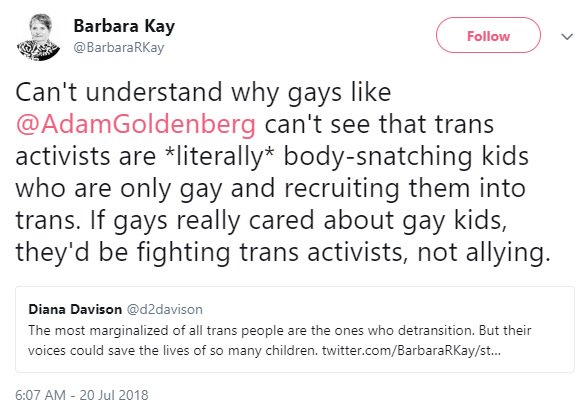
Janice Raymond, author of The Transsexual Empire: The Making of the She-Male and Doublethink: A Feminist Challenge to Transgenderism, forced a trans woman out of her job as a sound engineer for being trans. Raymond first had tried to out the woman to her coworkers, and then when it turned out the colleagues already knew and accepted her, started a campaign with the book that led death threats which got to be too much for the sound engineer. Raymond compared the woman’s existence to rape in her book:
All transsexuals rape women’s bodies by reducing the female form to an artifact, appropriating this body for themselves.
Janice Raymond, The Transsexual Empire: The Making of the She-Male
Sandy Stone, the transsexual engineer with Olivia Records, an “all-women” recording company, illustrates this well. Stone is not only crucial to the Olivia enterprise but plays a very dominant role there. The … visibility he [sic] achieved in the aftermath of the Olivia controversy … only serves to enhance his [sic] previously dominant role and to divide women, as men frequently do, when they make their presence necessary and vital to women. As one woman wrote: “I feel raped when Olivia passes off Sandy … as a real woman.”
Janice Raymond, The Transsexual Empire: The Making of the She-Male
I contend that the problem of transsexualism would best be served by morally mandating it out of existence.
Janice Raymond, The Transsexual Empire: The Making of the She-Male
Abigail Shrier, author of Irreversible Damage: The Transgender Craze Seducing Our Daughters, writes such bangers as “The Transgender Threat to Women’s Sports“, “The Transgender War on Women“, “The Transgender Language War“, “The Teen Trans Craze“, and is currently trying to get two teachers fired for creating safer schools for LGBTQ students (Shrier: “How Activist Teachers Recruit Kids“).
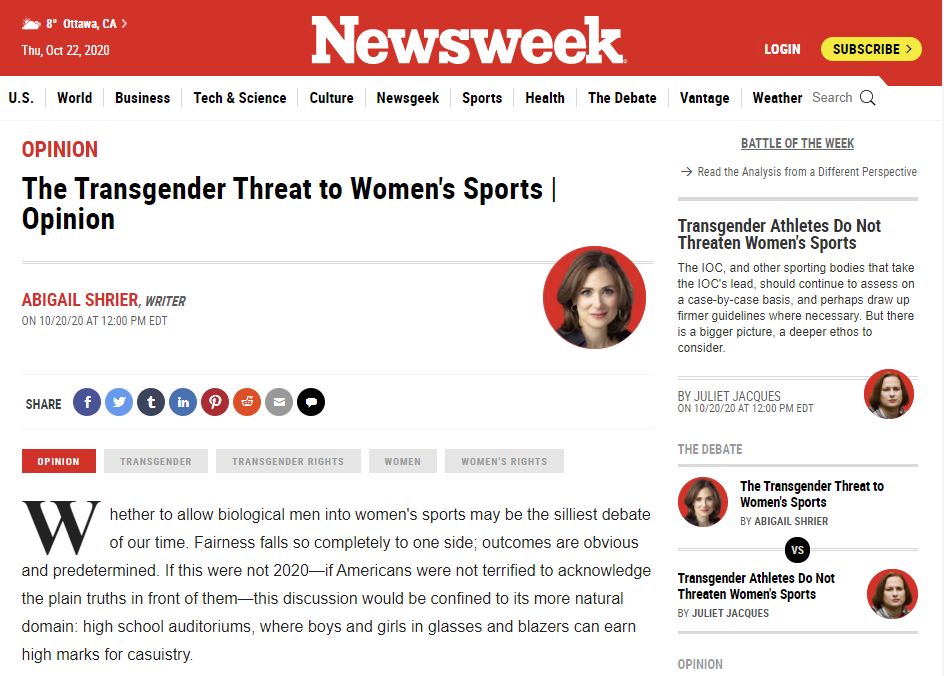
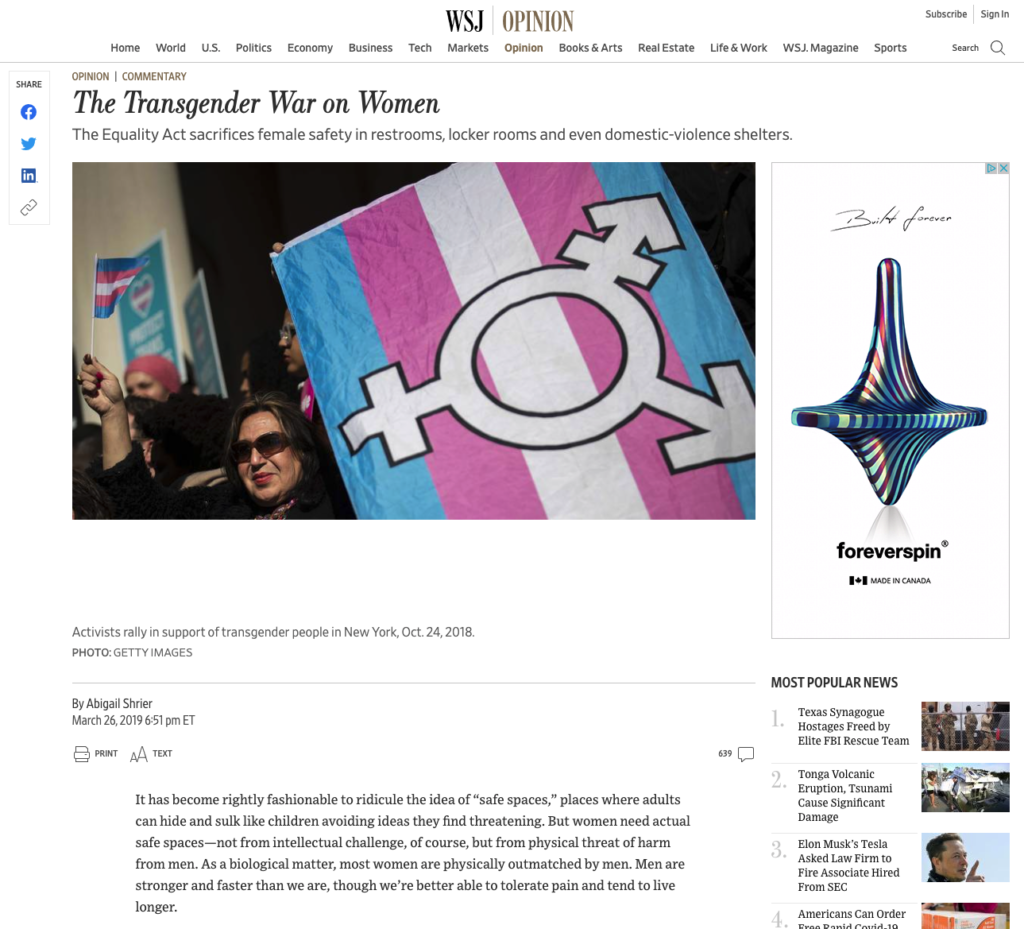
Some quotes
Major bookstores like Barnes & Noble carries The Transgender-Industrial Complex. It has four out of five stars on GoodReads. The description calls it “impeccably sourced and researched.” Here’s a random passage:
The proportion of whites is probably even lower given that Jews are classed as white… In the 2007 Annual Survey of American Jewish Opinion administered by Synovate, Inc. for the American Jewish Committee, the proportion of LGBT individuals among American Jews was at least 7%. This reality helps explain why LGBTQ is pushed so hard on whites…
Scott Howard, The Transgender-Industrial Complex
I counted. The term “Jew” and “Jewish” appears 1,128 times in the book. Scott Howard believes the whole trans thing is a Jewish conspiracy.
Other entries in the profitable get rid of trans people genre equate accepting trans women with rape:
“Transgender” is simply a made-up concept that is used to justify all kinds of atrocities… My aim is … to persuade readers that to the extent our society seems to have accepted the lie that “transgender” is real, it’s main victims are women and girls because the agenda is to obliterate sex… [It is the] “ultimate penetration of our bodies by men.”
Introduction, The Abolition of Sex: How the “Transgender” Agenda Harms Women and Girls
The “transgender ideology” conspiracy theory is another popular one:
People are waking up to the harms of trans for children and young people, but transgender ideology is still marching into schools disguised as LGBT acceptance.
Preface, Inventing Transgender Children and Young People
While Hollywood sought to mainstream transgender ideology, the federal government mandated it. The Obama administration pushed “gender identity” policies as a matter of civil rights in various domains – education, housing, health care, the military…. [it] would be used to violate the privacy, safety, and equality of women and girls.
Ryan T. Anderson, When Harry Became Sally: Responding to the Transgender Moment
These writers also have curious beliefs about who trans people are:
This book will explore the harms created by the ideology and practice of transgenderism, a phenomenon that developed in the mid to late twentieth century… The typical transgender tends to be 30 IQ points above average, they tend to be left-handed, they tend to be fairly conservative, they’ve been married, have children.
Sheila Jeffrey’s, Gender Hurts: A Feminist Analysis of the Politics of Transgenderism
A recurring theme are the author openness about disregarding the voices of trans people and medical professionals. Take Ray Blanchard of his belief that there are only two types of trans people – gay men, and straight men who get turned on mimicking women:
[My] ideas … were bitterly opposed as heretical innovations by the increasingly politicized transgender community and the clinicians who served it. My ideas included the notions that gender identity and sexuality are not separate and unrelated phenomena but rather two sides of the same coin… one is related to ordinary homosexuality and the other is related to autogynephilia. The contemporary dogma in the transgender and allied health communities was that male-to-female transsexualism is caused by a feminine gender identity—a proposition that is obviously and utterly circular…
Ray Blanchard, in his forward for Men Trapped in Men’s Bodies: Narratives of Autogynephilic Transsexualism
What a trip
In the sixties, people believed that poor relationship with the mother created lesbians. Now they believe that kids are catching the trans from YouTube. Absurd yet hardly a fringe view.
My local library, Ottawa Public Library, has 26 copies of Abigail Shrier’s Irreversible Damage: The Transgender Craze Seducing Our Daughters whose core thesis is exactly that. That’s more than any other book the library has on trans matters. The Economist called Craze “one of our best books of the year” (not a coincidence – see below.) The Wall Street Journal and Newsweek specifically invited Shrier to write pieces about trans people specifically because of the beliefs expressed in her book. These are some of the biggest periodicals in the United-States.
Men Trapped in Men’s Bodies: Narratives of Autogynephilic Transsexualism was published by academic mainstay Springer.
Trans: When Ideology Meets Reality written by The Economist editor Helen Joyce was a bestseller. The Telegraph got Kathleen Stock to review it. Stock wrote Material Girls: Why Reality Matters for Feminism, another book on our list, is a trustee for the anti-trans group LGB Alliance, and wrote a piece stating trans rights harm women in The Economist. She gave Joyce’s book five out of five stars. The Evening Standard called Trans a “must-read“. Jesse Singal at The New York Times said ““Trans” is a compelling, overdue argument for viewing self-ID more critically.” Helen Joyce would later become the Director of Advocacy for an anti-trans hate group presenting itself as a sex-based rights org called Sex Matters.
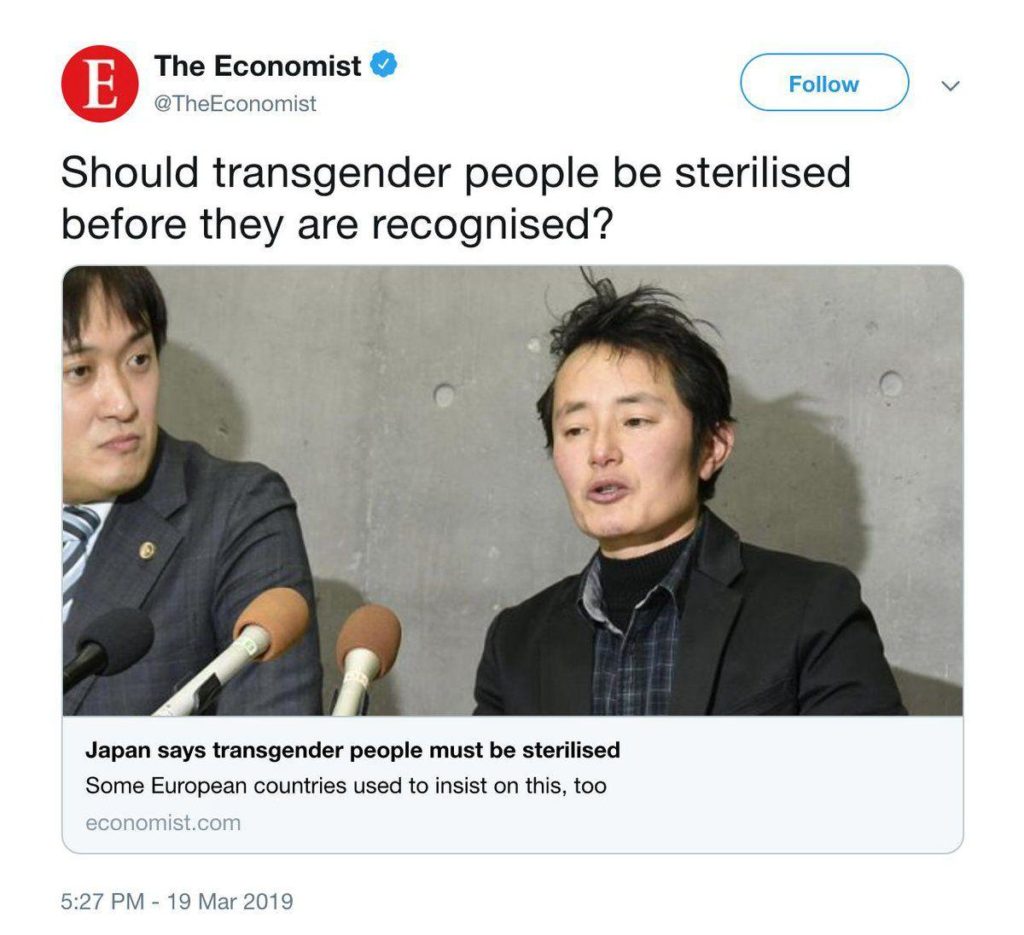
Straight people believed all these things about “the homosexuals” because they only allowed straight people to write about the topic. They built on each others ignorance to create a foe that only existed in their imagination.
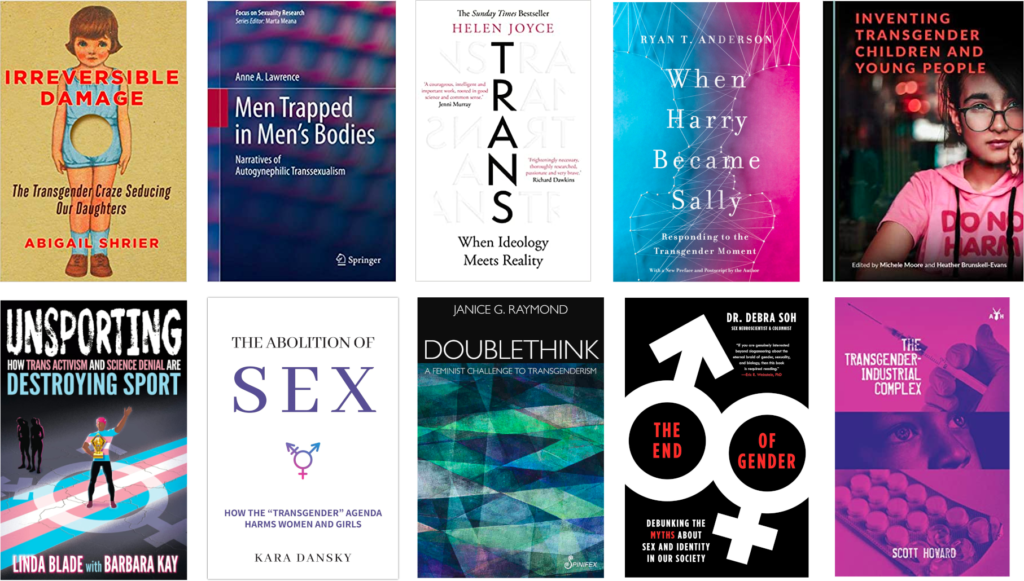
History is repeating as cis people grant each other publishing opportunities and pat themselves on the back for cultivating these fictions about who trans people are. As long as the publishing world denies trans people the same freedom to write about themselves, so long as they continue to shut out trans people from decision-making positions, they will continue to produce the comedy material of future generations.
